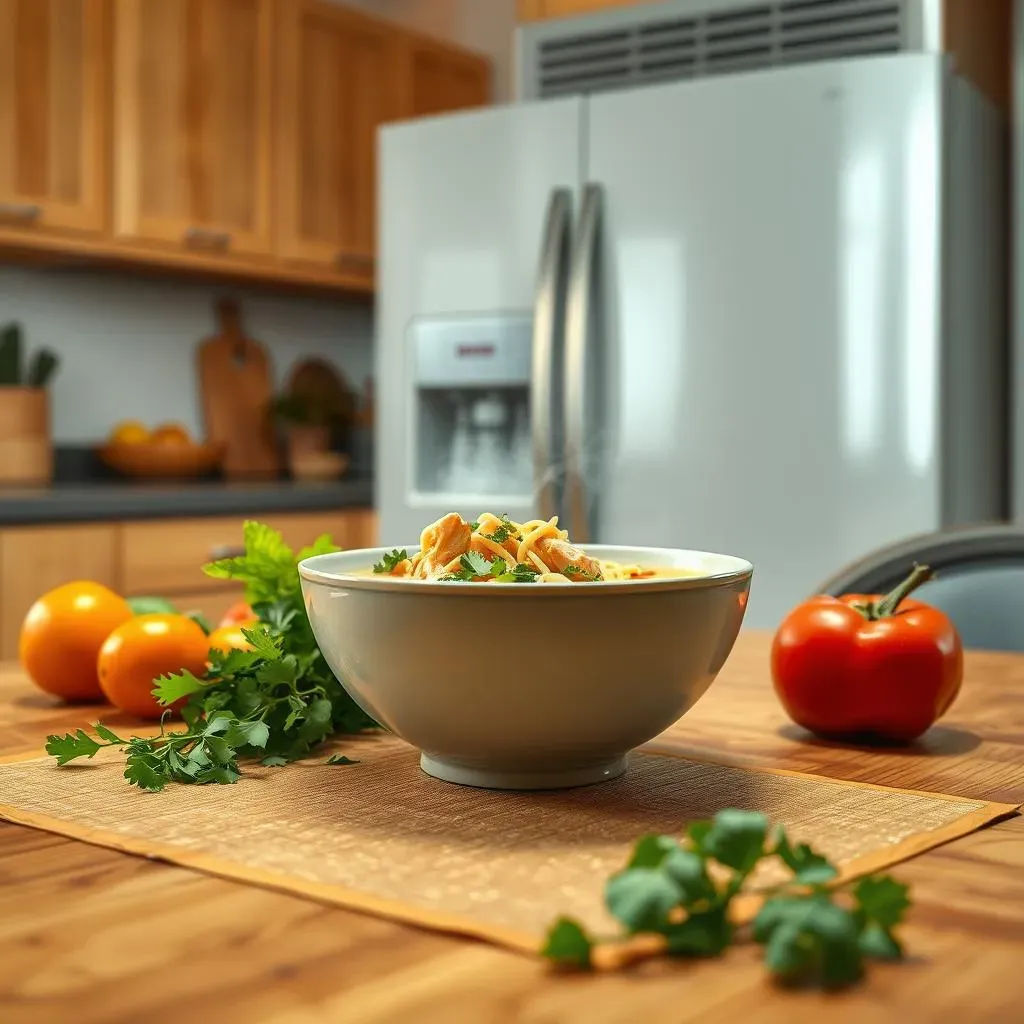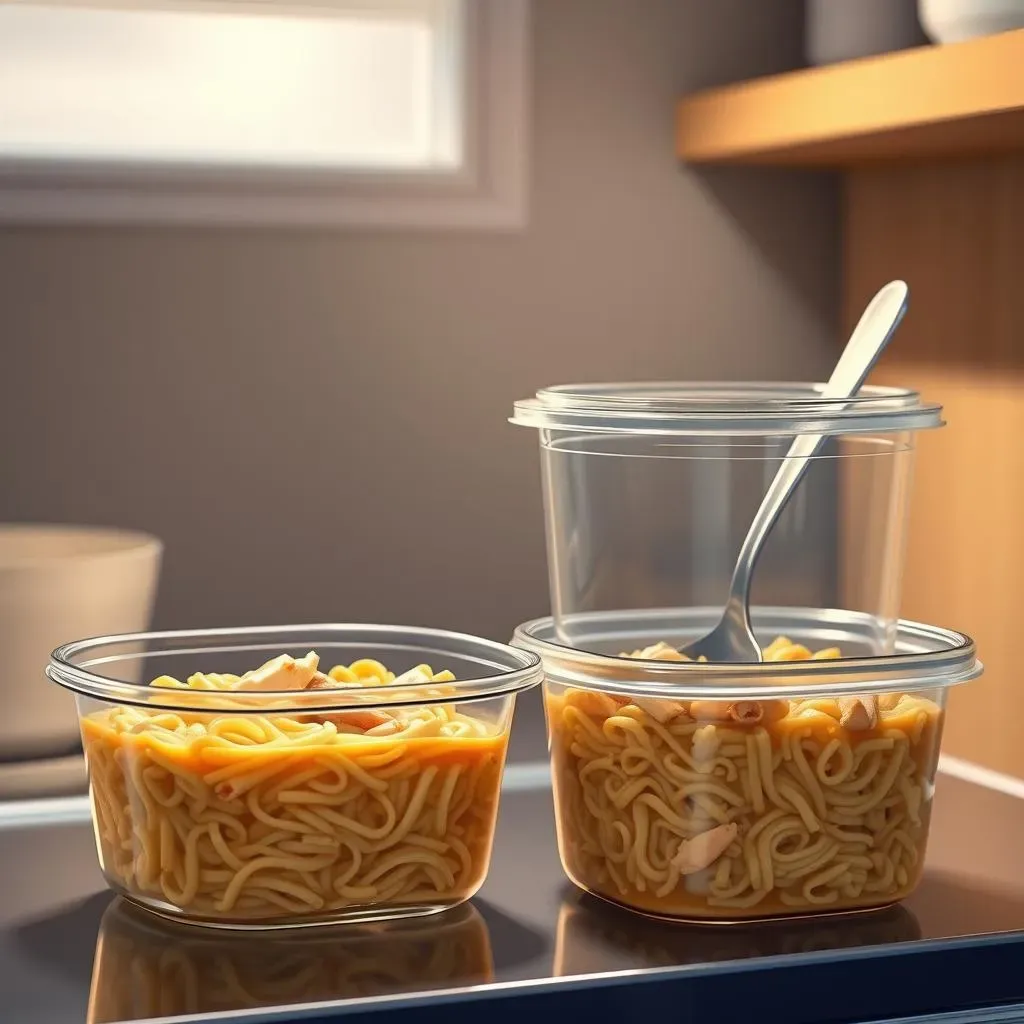Table of Contents
Okay, let’s be real. You’ve made a big pot of chicken noodle soup, it’s comforting, it’s delicious, and now you're staring at a mountain of leftovers. What do you do? If you're like me, you've probably wondered "what's the best way to store chicken noodle soup leftovers?" because no one wants soggy noodles and a sad, flavorless broth. I've been there, done that, and learned a few tricks along the way. This isn't just about shoving it in a container and hoping for the best. We're talking about keeping your soup tasting just as good, if not better, than the first time. So, stick with me, and we'll go over the ins and outs of how to store chicken noodle soup leftovers, from fridge to freezer, and even how to reheat it without turning it into a mushy mess. Get ready to become a leftover soup ninja!
Why Proper Storage Matters for Chicken Noodle Soup Leftovers

Why Proper Storage Matters for Chicken Noodle Soup Leftovers
Alright, let's talk about why you can't just leave your leftover chicken noodle soup sitting on the counter all night. It's not just about being a neat freak, it's about safety and flavor! Proper storage is like giving your soup a little spa day before its next debut. Think about it, bacteria are sneaky little critters that love to party in warm, moist environments, exactly like your soup if it's left out. So, if you want to avoid a tummy ache, and keep that rich flavor, you've gotta store it right. Plus, who wants mushy noodles? Nobody, that's who! Proper storage also helps to keep the noodles from getting all bloated and sad, retaining their texture and taste.
Reason | Benefit |
|---|---|
Prevent Bacteria Growth | Avoid food poisoning and tummy troubles. |
Maintain Flavor | Keep the soup tasting delicious, not bland. |
Preserve Texture | Avoid mushy noodles and a watery broth. |
Best Ways to Store Chicken Noodle Soup Leftovers: Fridge and Freezer

Best Ways to Store Chicken Noodle Soup Leftovers: Fridge and Freezer
Alright, so you're ready to store that liquid gold, huh? You've got two main options when it comes to keeping your chicken noodle soup leftovers safe and tasty: the fridge and the freezer. The fridge is your go-to for short-term storage, like if you're planning to eat it within the next few days. Think of it as a comfy, cool place for your soup to chill out. On the other hand, the freezer is like a time capsule for your soup, perfect if you want to save it for a rainy day (or a busy week). It's like hitting the pause button on your soup's freshness. But here's the deal, each method has its own little quirks you need to know about to make sure it stays delicious.
For fridge storage, you want to make sure your soup cools down quickly before putting it away. I usually transfer my soup to shallow containers to speed up this process, because you don't want a warm soup sitting in the fridge for too long. Once cooled, pop it into airtight containers because this also helps to avoid any fridge odors sneaking in to your soup. You should aim to eat it within 3-4 days to get the best taste and avoid any unwelcome bacteria guests. If you're looking at storing it for longer than that, that's when the freezer comes in.
Storage Method | Best For | Storage Time | Tips |
|---|---|---|---|
Fridge | Short-term storage | 3-4 days | Cool quickly, use airtight containers |
Freezer | Long-term storage | 2-3 months | Use freezer-safe containers, leave some headspace |
Now, when it comes to freezing, you've got to plan a bit more. The key is to use freezer-safe containers or bags. I prefer bags because they can lie flat in the freezer, saving space and also helping the soup freeze faster. Be sure to leave a little bit of headspace in your containers or bags because liquids expand when frozen, and you don't want your container to burst. When you're ready to thaw your soup, move it to the fridge overnight, or if you’re in a rush, use the defrost setting on your microwave. Just remember, freezing can slightly alter the texture of noodles, so don’t be surprised if they're a little softer than they were when freshly made.
Tips for Reheating Chicken Noodle Soup Leftovers Without Ruining It

Tips for Reheating Chicken Noodle Soup Leftovers Without Ruining It
The Gentle Approach: Stovetop Reheating
Okay, so you've got your beautifully stored chicken noodle soup, now what? Reheating is where things can go south real quick if you're not careful. My go-to method is always the stovetop. It's like giving your soup a warm hug instead of a blast of heat. You want to pour your soup into a pot and heat it over a medium-low flame. This is important because you don't want to scorch the bottom and create a burnt flavor, nobody likes that. Stir it occasionally to distribute the heat evenly and also to make sure nothing is sticking to the bottom.
Patience is key here, don't crank up the heat hoping to get it done faster. The gentle approach helps keep the noodles from turning to mush and the broth from getting too watery. It also helps to preserve the flavors, letting them meld together again just like they did when you first made the soup. You'll know it's ready when it’s heated through, and the steam is gently rising from the pot.
Quick and Easy: Microwave Reheating
Sometimes, you just need your soup NOW, and that’s when the microwave comes in handy. It's quick, it's easy, and it gets the job done, but you gotta be careful. The key to successful microwave reheating is to use a microwave-safe bowl and to heat it in intervals. Start with a minute, then stir, and then continue with 30 second intervals until it’s hot. This will ensure your soup is heated evenly and prevent those dreaded hot spots.
I find that covering the bowl with a microwave-safe lid or plate can help to keep the moisture in and prevent splattering, because no one likes cleaning up soup from inside the microwave. Also, avoid heating it for too long in one go as it can make the noodles go mushy really quickly. And, like the stovetop method, patience is key, even in the microwave.
Reheating Method | Pros | Cons | Tips |
|---|---|---|---|
Stovetop | Gentle heat, preserves texture and flavor | Slower than microwave | Use medium-low heat, stir occasionally |
Microwave | Quick and convenient | Can create hot spots, might overcook noodles | Heat in intervals, cover bowl to retain moisture |
Reviving the Noodles: A Pro Tip
Now, here's a little secret I've learned: if you're really worried about your noodles becoming too soft, consider cooking them separately. If you know you're going to have leftovers, boil the noodles just until they're al dente, then drain and store them separately. This way, when you go to reheat your soup, you can add the noodles at the very end. This trick keeps them from getting mushy and ensures that they maintain a good texture.
Another thing you can do is add a splash of fresh broth or water when reheating if it seems too thick. This can help bring back the original consistency and flavor. Remember, reheating is not just about getting the soup hot, it’s also about bringing it back to life, so treat it with care, and it will reward you with a delicious second meal.
